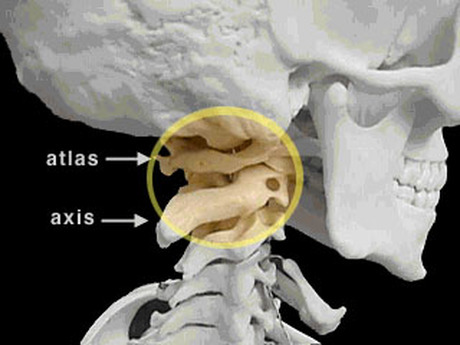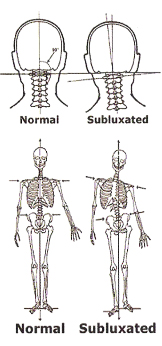What are the Signs and Symptoms of Atlas Subluxation Complex (ASC)?
By Dr. Grayson Blom - Boise, Idaho
The very first bone in the neck is called Atlas or C1 for short and it is a ring like bone at the junction where the head and neck meet. The second neck bone is called Axis or C2 for short and is found just below Atlas. Atlas and Axis together are commonly referred to as the upper cervical spine. The Atlas and Axis are in close proximity to a portion of your central nervous system called the brain stem. The brain stem controls and coordinates virtually all of your body's vital functions. When damage to the connective tissues occurs due to accidents and injuries, Atlas and Axis can misalign and lock into a stressed abnormal position, resulting in pressure, tension, irritation, disruption to blood flow and cerebrospinal fluid circulation. Atlas/Axis subluxation will also result in Postural Distortion in the spine below.
It is critical to note that an Atlas, Axis Subluxation will remain stuck in its abnormal configuration slowly causing health problems over time, with the average time to onset of symptoms being 10-15 years.
It is critical to note that an Atlas, Axis Subluxation will remain stuck in its abnormal configuration slowly causing health problems over time, with the average time to onset of symptoms being 10-15 years.
Signs and Symptoms of Atlas Subluxation Complex
Here is a list of some of the most common signs and symptoms of Atlas Subluxation Complex. Please note that the average case we see in the office will have at least 3 of the following signs and symptoms.
1. Neck Pain, Stiffness, Muscle Ache
2. Headaches that frequently involve the base of the skull and radiate usually to one side of the head.
3. Migraine's that not only produce a throbbing pain but may cause visual disturbance, nausea, or vomiting.
4. Vertigo, Dizziness, Faintness, ringing in the ears (tinnitus) and some types of hearing loss.
5. Facial Pain or Palsy (Trigeminal Neuralgia, Bells Palsy)
6. Grating or crackling sounds in the neck or at the base of the skull when turning the head or neck.
7. Inability to fully turn or lean your head to one side or the other (loss of range of motion).
8. Shoulder pain that is commonly between the shoulder blades but can occur between the neck and shoulder area as well.
9. Jaw pain that is typically behind the jaw or close to the ear.
10. Postural Distortion:
a. Head Tilt
b. Shoulder Tilt
c. Pelvic Tilt
d. Short Leg
e. Please note that head, shoulder, rib cage, and pelvic rotation can also occur.
11. Chest or Rib ache, discomfort, or pain From Postural Distortion.
12. Nerve root irritation can occur at the resulting stress points along the spine.
13. Radiating arm pain, shoulder pain and leg pain (sciatica) can develop through nerve root tension and irritation.
14. Low back pain and spinal disc damage occur over time due to Postural Distortion.
15. Hip, knee, or ankle pain and dysfunction typically on the side of the short leg.
16. Brain congestion due to mechanical blockage of blood flow, particularly venous drainage and cerebrospinal fluid circulation. (Current research is pointing to neurodegenerative disorders developing over time due to long term brain congestion).
17. High Blood Pressure (neurologically based)
18. Vagus nerve disruption can present as heart, lung, stomach, digestive, and bowl disorders.
19. Dysautonomia due to imbalance between sympathetic (fight or flight system) and parasympathetic (rest and digest system) nervous system which most commonly results in over-activity of the fight or flight response leading to a chronic stress state.
20. Difficulty sleeping, insomnia and some cases grind their teeth at night (bruxism).
1. Neck Pain, Stiffness, Muscle Ache
2. Headaches that frequently involve the base of the skull and radiate usually to one side of the head.
3. Migraine's that not only produce a throbbing pain but may cause visual disturbance, nausea, or vomiting.
4. Vertigo, Dizziness, Faintness, ringing in the ears (tinnitus) and some types of hearing loss.
5. Facial Pain or Palsy (Trigeminal Neuralgia, Bells Palsy)
6. Grating or crackling sounds in the neck or at the base of the skull when turning the head or neck.
7. Inability to fully turn or lean your head to one side or the other (loss of range of motion).
8. Shoulder pain that is commonly between the shoulder blades but can occur between the neck and shoulder area as well.
9. Jaw pain that is typically behind the jaw or close to the ear.
10. Postural Distortion:
a. Head Tilt
b. Shoulder Tilt
c. Pelvic Tilt
d. Short Leg
e. Please note that head, shoulder, rib cage, and pelvic rotation can also occur.
11. Chest or Rib ache, discomfort, or pain From Postural Distortion.
12. Nerve root irritation can occur at the resulting stress points along the spine.
13. Radiating arm pain, shoulder pain and leg pain (sciatica) can develop through nerve root tension and irritation.
14. Low back pain and spinal disc damage occur over time due to Postural Distortion.
15. Hip, knee, or ankle pain and dysfunction typically on the side of the short leg.
16. Brain congestion due to mechanical blockage of blood flow, particularly venous drainage and cerebrospinal fluid circulation. (Current research is pointing to neurodegenerative disorders developing over time due to long term brain congestion).
17. High Blood Pressure (neurologically based)
18. Vagus nerve disruption can present as heart, lung, stomach, digestive, and bowl disorders.
19. Dysautonomia due to imbalance between sympathetic (fight or flight system) and parasympathetic (rest and digest system) nervous system which most commonly results in over-activity of the fight or flight response leading to a chronic stress state.
20. Difficulty sleeping, insomnia and some cases grind their teeth at night (bruxism).
Atlas Subluxation Complex (ASC) Doctors in Boise Idaho
Dr. Grayson Blom is an Upper Cervical Chiropractic specialist located in Boise Idaho. Specializing in the detection and correction of Atlas Subluxation Complex (ASC). If you suspect you are suffering from Atlas Subluxation Complex (ASC) we invite you to give us a call to schedule a consultation to determine if you are a candidate for care. You can call (208) 559-0541 or "click" to schedule.
REFERENCES:
1. Eriksen, K. Upper Cervical Subluxation Complex: A review of the chiropractic and medical literature. (2004)
2. Eriksen, K. Rochester, R.P. Orthospinology Procedures: An evidence based approach to spinal care. (2007)
3. Thomas, M.D. NUCCA Protocols and Perspectives: A textbook for the national upper cervical chiropractic association. First Edition. (2002)
4. Palmer, B.J. The Subluxation Specific Adjustment Specific, Davenport IA, (1934)
5. Palmer, B.J. Chiropractic Clinical Controlled Research. Davenport, IA, (1951)
6. Upper Cervical Diplomate Program, Sherman College of Straight Chiropractic. Spartanburg, SC, (2005)
7. Upper Cervical Diplomate Program, ICA Council on Upper Cervical Care, (20
2. Eriksen, K. Rochester, R.P. Orthospinology Procedures: An evidence based approach to spinal care. (2007)
3. Thomas, M.D. NUCCA Protocols and Perspectives: A textbook for the national upper cervical chiropractic association. First Edition. (2002)
4. Palmer, B.J. The Subluxation Specific Adjustment Specific, Davenport IA, (1934)
5. Palmer, B.J. Chiropractic Clinical Controlled Research. Davenport, IA, (1951)
6. Upper Cervical Diplomate Program, Sherman College of Straight Chiropractic. Spartanburg, SC, (2005)
7. Upper Cervical Diplomate Program, ICA Council on Upper Cervical Care, (20


No comments:
Post a Comment